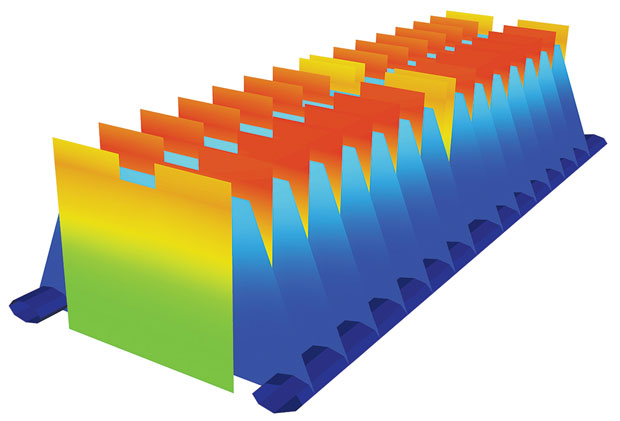
ThermoAnalytics describes its Battery Module for TAITherm as engineered to help OEMs (original equipment manufacturers) and suppliers test, experiment and validate a battery’s thermal management optimization virtually, eliminating time, expense and risk in the process. This image here depicts a battery pack analysis with TAITherm. Image courtesy of ThermoAnalytics Inc.
Latest News
July 1, 2015
 The TAITherm Human Thermal Module allows engineers to test for human comfort rather than simple climate controls. This image from the ThermoAnalytics website depicts a comfort simulation using two model manikins in a Ford F-350 on an Arizona afternoon in August. Image courtesy of ThermoAnalytics Inc.
The TAITherm Human Thermal Module allows engineers to test for human comfort rather than simple climate controls. This image from the ThermoAnalytics website depicts a comfort simulation using two model manikins in a Ford F-350 on an Arizona afternoon in August. Image courtesy of ThermoAnalytics Inc.ThermoAnalytics Inc. has released version 12.0 of its flagship thermal modeling software solution and rebranded it to better reflect the product’s expanded analysis capabilities over its nearly 20 years of development. The company says that TAITherm, formerly known as RadTherm, has been updated with a variety of enhancements created to suit user needs.
Design and engineering teams use TAITherm – pronounced Tee-Aye-Eye-Therm – to predict the full range of temperature distribution in a product or system, according to the company. TAITherm applies a multiphysics approach to solve for thermal conduction, radiation and convection under both steady-state and transient conditions. The software can be used to study virtual prototypes from the earliest stages of development through final validations. The software is engineered to solve and scale from fast 1D models to detailed 3D models. Human and battery thermal modeling modules extend TAITherm’s capabilities for these specialized thermal management disciplines.
Among the new features in the 12th edition of TAITherm are:
- Distributed computing capabilities for multi-grid and partial-direct solvers to be run in parallel, which the company reports leads to a significant thermal solution speed up.
- Post-processing relations that enable users to isolate or emphasize component relationships and visualize component-to-component energy contributions.
- Pass/Fail/Warning status for component parts so that users can analyze minimum or maximum design temperature.
 ThermoAnalytics describes its Battery Module for TAITherm as engineered to help OEMs (original equipment manufacturers) and suppliers test, experiment and validate a battery’s thermal management optimization virtually, eliminating time, expense and risk in the process. This image here depicts a battery pack analysis with TAITherm. Image courtesy of ThermoAnalytics Inc.
ThermoAnalytics describes its Battery Module for TAITherm as engineered to help OEMs (original equipment manufacturers) and suppliers test, experiment and validate a battery’s thermal management optimization virtually, eliminating time, expense and risk in the process. This image here depicts a battery pack analysis with TAITherm. Image courtesy of ThermoAnalytics Inc.New thermal probes for analyzing temperatures at any depth of a solid model debut in version 12.0. This capability, explains the company, provides users with the ability to compare results from measured thermocouple locations to measurement data results without having to know specific element numbers.
TAITherm’s graphics for rendering performance now exhibits a 10x to 100x speed increase, says ThermoAnalytics. Other graphics related functions include a new gridline feature that enables users to visualize components even in the most complex models and a new red, white and blue color scale has been added to the graphics window, which can help when visualizing conduction paths.
 Users can import solid objects in TAITherm (formerly RadTherm) using a volume mesh and solve the internal temperature distribution under steady-state or transient conditions. Image courtesy of ThermoAnalytics Inc.
Users can import solid objects in TAITherm (formerly RadTherm) using a volume mesh and solve the internal temperature distribution under steady-state or transient conditions. Image courtesy of ThermoAnalytics Inc.ThermoAnalytics reports that TAITherm provides several other enhancements in such areas of functionality as post-processing, human thermal comfort, view factors and CAE coupling. For more on these additional enhancements and on the 12.0 version of TAITherm (RadTherm), visit ThermoAnalytics.
Go here for more details on what’s new in TAITherm (formerly RadTherm) version 12.0.
Request an evaluation version of TAITherm.
Check out the ThermoAnalytics blog.
See why DE‘s editors selected the TAITherm thermal modeling solution as their Pick of the Week.
Sources: Press materials received from the company and additional information gleaned from the company’s website.
Subscribe to our FREE magazine, FREE email newsletters or both!
Latest News
About the Author
Anthony J. Lockwood is Digital Engineering’s founding editor. He is now retired. Contact him via [email protected].
Follow DE




